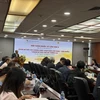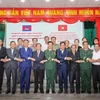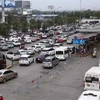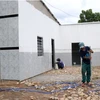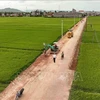The number of poor households in Hanoi has dropped by 1.5 percent on average each year since the capital city’s boundary expansion in 2008, a Hanoi official has said.
Nguyen Cong Soai, Deputy Permanent Secretary of the Hanoi municipal Party’s Committee, said the development gap between inner and outer districts has been narrowed while health and education services have been improved.
During the reviewed period, the panorama of Hanoi’s rural areas has seen significant changes thanks to the capital city’s investment in production, upgrading the irrigation system and mechanisation.
Many large-scale production areas have been formed, serving both domestic consumption and export, Soai said, citing the establishment of many vegetable, fruit and husbandry farms in the outskirts districts of Thanh Oai, Soc Son and Ba Vi, among many others.
The city has also made efforts to upgrade the transport system in these areas, bring electricity to all households and help build and repair houses for over 3,800 poor families.
The official highlighted the consensus of local authorities and people to build new style rural areas and hailed the work undertaken to raise public awareness of the benefits brought by the model.
He underlined the importance of initiatives and innovations in management as well as agricultural production, contributing to building the rural infrastructure in a sustainable manner.
According to the Hanoi Department of Agriculture and Rural Development, the average per capita income in the city’s rural areas reached more than 21 million VND last year and the number of rural labourers made up about 48 percent of the social workforce.-VNA
Nguyen Cong Soai, Deputy Permanent Secretary of the Hanoi municipal Party’s Committee, said the development gap between inner and outer districts has been narrowed while health and education services have been improved.
During the reviewed period, the panorama of Hanoi’s rural areas has seen significant changes thanks to the capital city’s investment in production, upgrading the irrigation system and mechanisation.
Many large-scale production areas have been formed, serving both domestic consumption and export, Soai said, citing the establishment of many vegetable, fruit and husbandry farms in the outskirts districts of Thanh Oai, Soc Son and Ba Vi, among many others.
The city has also made efforts to upgrade the transport system in these areas, bring electricity to all households and help build and repair houses for over 3,800 poor families.
The official highlighted the consensus of local authorities and people to build new style rural areas and hailed the work undertaken to raise public awareness of the benefits brought by the model.
He underlined the importance of initiatives and innovations in management as well as agricultural production, contributing to building the rural infrastructure in a sustainable manner.
According to the Hanoi Department of Agriculture and Rural Development, the average per capita income in the city’s rural areas reached more than 21 million VND last year and the number of rural labourers made up about 48 percent of the social workforce.-VNA
